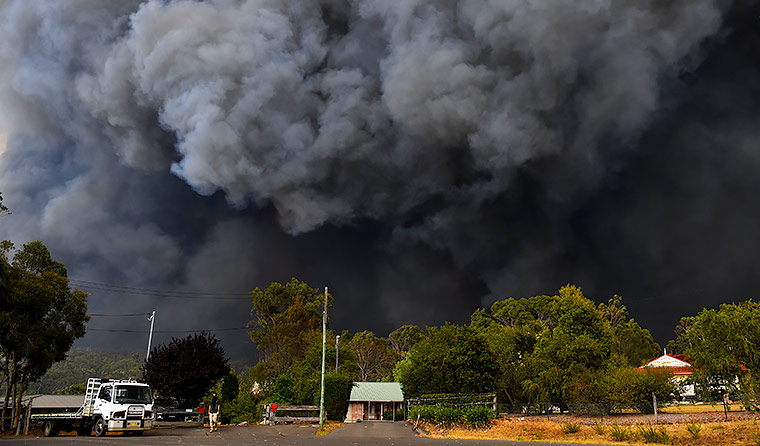News
Bushfire disaster: How GPs can help
An unprecedented start to the bushfire season has pushed emergency services, communities and volunteers to breaking point.
 The RACGP will this week meet with the Department of Health to raise the issue of greater support for GPs in affected communities.
The RACGP will this week meet with the Department of Health to raise the issue of greater support for GPs in affected communities.
Dozens of lives and hundreds of properties have been lost as out-of-control bushfires torch millions of hectares of land, while even major cities far removed from the immediate danger have been inundated with toxic smoke.
The widespread scale of the threat has led to five hospital relocations in NSW and, for the first time, Australian Medical Assistance Team (AUSMAT) specialists have been deployed domestically to help people in affected communities.
Thousands of Australians remain stranded in evacuation centres, some with no homes left to go to, while fears of a ‘mega-fire’ developing across the border of New South Wales and Victoria mean the worst may yet be to come.
In response to the crisis, state and federal governments have enlisted the Australian Defence Force (ADF), drafted in firefighters from the US, and provided 450,000 facemasks from the National Medical Stockpile.
However, there so far has been limited assistance or coordination for GPs providing medical care on the frontlines, or for those who would like to volunteer.
The RACGP will this week meet with the Department of Health to raise the issue of greater support for GPs in affected communities.
‘GPs should be included in emergency planning and responses, but are currently falling through the cracks because emergency planning and response is a matter for state governments, while general practice is covered by the Federal Government,’ President Dr Harry Nespolon told newsGP.
‘For years after the fires have been extinguished and the politicians have gone back to Canberra, GPs will be carrying the medical and mental support of those directly and indirectly affected by these extraordinary bushfires.
‘GPs have been doing truly amazing work under incredibly trying conditions. Yet reports from the frontline suggest there is an urgent need for more medical care in these areas, and the Government should be doing everything it can to help facilitate this assistance.
‘For example, there should be a comprehensive, centralised process to assist GPs who want to act as locums in affected areas so we can have medical care where it is most needed.’
Dr Nespolon said there also needs to be consideration of and advocacy for the financial and emotional toll the bushfires will have on rural practitioners.
‘GPs need to be able to provide quality care to those affected by fires without going broke themselves,’ he said.
‘Greater financial supports for GPs providing patient services to impacted people and communities, including through the Medicare Benefits Schedule [MBS], is one option.
‘The RACGP recognises climate change as a public health emergency. As fires like these become more common place due to climate change, it is important that we develop short-, medium- and long-term responses involving primary care to protect the health and wellbeing of our communities.
‘“Thoughts and prayers” are nice but we actually want to be there helping, and to do that we need information from people on the ground.
‘We will be contacting GPs in impacted communities to see how we can help, but I would also encourage any GP in need of more urgent assistance to contact the RACGP.’
Disaster medicine specialist Dr Penny Burns previously told newsGP one way GPs can help during disasters is to try and keep clinics running ‘as usual’ and, if possible, expand to accommodate increased numbers or different presentations.
‘This helps take the load off EDs [emergency departments] and other responders,’ she said.
‘In larger, more catastrophic disasters, GPs may be required to respond to the site or assist at a temporary medical clinic or evacuation centre.’
There can also be specific health concerns for which GPs need to keep an eye out, depending on the type of disaster taking place.
‘Two early issues for GPs to identify in an acute event are increase in blood pressure in those with and without hypertension, and medication compliance,’ Dr Burns said.
‘In smoke-related events … effects on those with pre-existing respiratory conditions will need to be considered, with either early evacuation or advice to remain inside and review of management including medications.
‘Also, smoke and dust can cover hundreds of kilometres, so it is not just GPs in the immediate area that need to be aware of the risks for their patients but also those on the edges of these events.’
Once the disaster event has passed, GPs’ efforts within the community can be extremely helpful in the next phase of treatment.
‘GPs have a role in supporting patients in acute distress, and with immediate need for medications and management of acute changes in their pre-existing medical conditions and lower acuity injuries,’ Dr Burns said.
‘GPs can identify those most at risk and make sure they are reviewed, as well as those whose distress is continuing and require further management or referral.
‘They are also aware of the family and community context so are able to monitor those who may have experienced substantial loss or bereavement.’
More information for GPs impacted by bushfires can be found on the RACGP website, and the college can be contacted at 1800 472 247.
Log in below to join the conversation.
bushfires climate change emergency medicine RACGP
newsGP weekly poll
Health practitioners found guilty of sexual misconduct will soon have the finding permanently recorded on their public register record. Do you support this change?